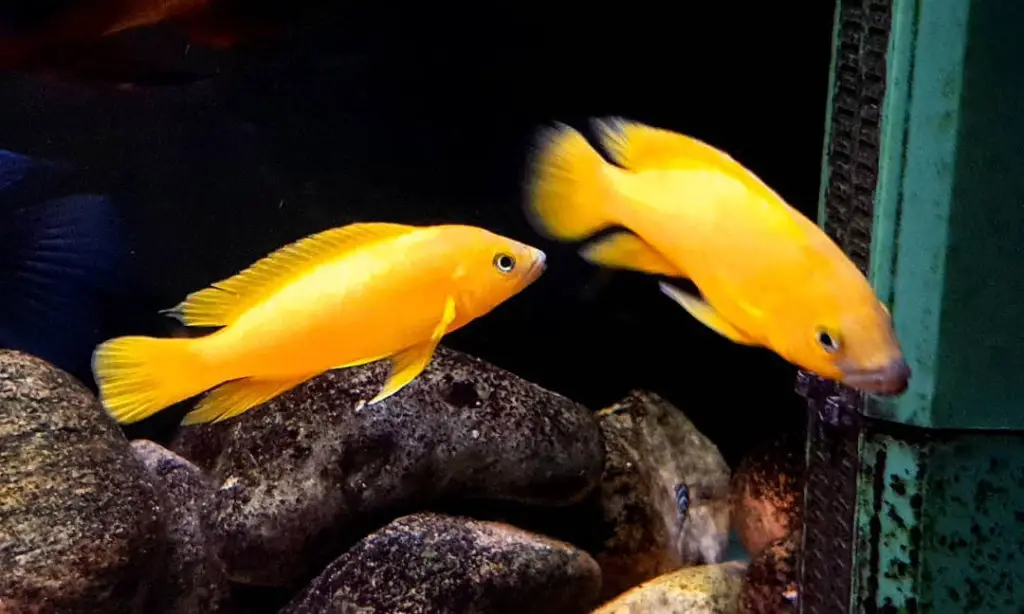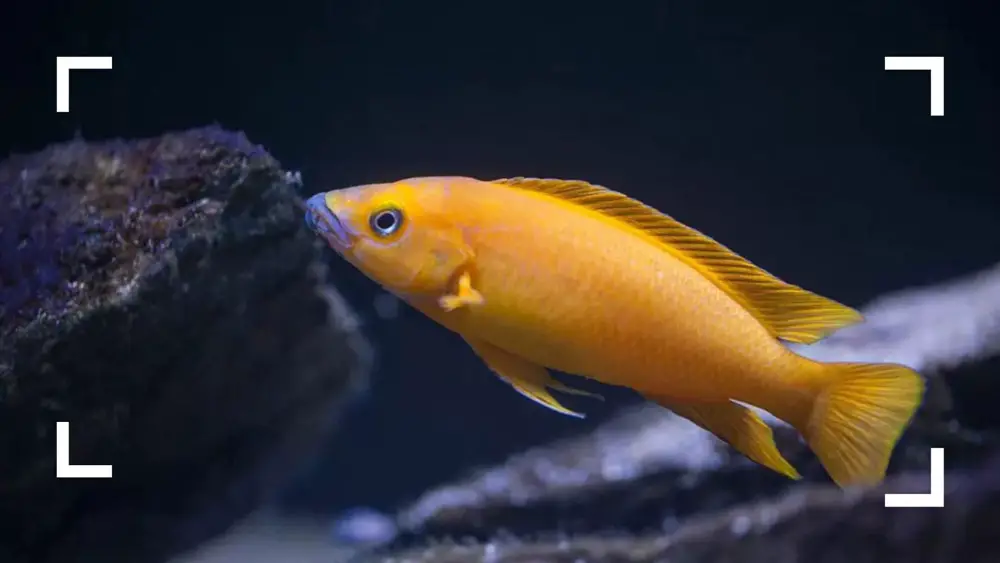The Lemon Cichlid (Neolamprologus leleupi) is one of the most popular species found in the vast and diverse Lake Tanganyika. It is a small, extremely active, and relatively aggressive community fish for both the intermediate and experienced cichlid keepers.
Whether you are an intermediate fish-keeping hobbyist just starting out with cichlids or you’re an experienced cichlid looking for something new, the Lemon Cichlid is sure to delight and amaze you with its vibrant color and unique personality.
While these species are relatively easy to care for, there are certain things that you should know about before adding them to your tank. Here’s the guide to teach you Lemon Cichlid care, appearance, lifespan, and more.
Species Summary
The Lemon Cichlid (Neolamprologus leleupi) is also known as the Orange Cichlid, Gold Cichlid, and Gold Leleupi Cichlid. It originates from Lake Tanganyika in Africa, where it occurs throughout this large body of water, and you can mostly see them in the southern part of the lake.
The Lemon Cichlid inhabits the rocky coastal areas along the shoreline, where it primarily feeds on invertebrates that live beneath the cover of its habitat. This species belongs to the family of Cichlidae and the subfamily of Pseudocrenilabrinae.
The Neolamprologus genus is the largest genus of Lake Tanganyika cichlids, and there are currently 46 recognized species. All members in this genus are substrate spawners, divided into two groups, including shell dwellers and rock dwellers.
Typically bright yellow-colored mature Cichlids are rare, let alone young juveniles, making the Lemon Cichlid a unique and highly sought-after addition to your aquarium.
| Scientific Name: | Neolamprologus leleupi |
| Common Name: | Lemon Cichlid, Orange Cichlid, Gold Cichlid, and Gold Leleupi Cichlid |
| Care Level: | Intermediate |
| Lifespan: | 8 – 10 years |
| Max Size: | 3.9 inches (10 cm) |
| Temperature: | 73 – 81°F (23-27°C) |
| PH: | 7.6- 9 |
| Water hardness: | 12 – 15 |
| Diet: | Carnivore |
| Minimum Tank Size: | An adult pair: 20 gallons; 55+ gallons for a group |
| Temperament: | Aggressive |
Appearance

This beautiful rock-dwelling cichlid is highly prized by both hobbyists and researchers alike due to the bright yellow coloration that gives it its name.
Depending on where you find this fish, its colors vary from yellow to brown or red-brown, but it is most commonly found in bright, canary yellow. The creature’s body is elongated, and it has a surprisingly large mouth for its size that’s outlined in black or blue.
They also have darker coloring around their causal and dorsal fins. There are three currently known wild color morphs of this species: the bright yellow-orange, a brown-black, and a silvery beige. The bright yellow-orange variety is the most popular and regularly traded.
This black-brown variant features yellow pigment as the bright-orange morph, but the strength of the brown-black pigment obscures this. These cichlids have a greenish or blue line above their large lips that runs to just below the light-blue eyes.
In your local fish store, the N. leleupi could be confused with the species N. leloupi, which tends to have a slightly more elongated body.
Neolamprologus leleupi (Lemon Cichlid) Size
The maximum size Neolamprologus leleupi (Lemon Cichlid) can grow up to is 3.9 inches (10 cm). Male lemon cichlids are slightly larger and can reach up to 4 inches, and females are typically smaller and can grow close to 3 ½ inches.
When Lemon Cichlids are available for purchase, they are usually 1″ to 1-1/2″ in length. This fish is slow-growing fish; it may take 2 years to reach sexual maturity.
Don’t get fooled by their smaller size, as they are highly territorial, with all other specimens entering their territory. Due to their small size, these species are ideal for aquarists who want fish for their standard-sized tanks.
Lifespan
The average lifespan of lemon cichlids is about 8 – 10 years. With proper care and a balanced diet, you can extend their life expectancy by a few more years.
However, there’s no guarantee, and the quality of care you provide is all that matters. Fish with poor tank conditions and an inappropriate diet might succumb to diseases. So, take optimal care of N. leleupi and add years to their life.
Neolamprologus leleupi (Lemon Cichlid) Care
The Lemon Cichlid care is quite manageable for intermediate and experienced cichlid hobbyists. These fish are relatively undemanding as long they are fed live foods.
The aquarists must be willing to provide a properly set up aquarium with appropriate tank mates and be willing to do frequent water changes. It is a more peaceful cichlid that can be kept with other fish but will be aggressive towards others of its own kind.
Lemon Cichlids require good filtration, oxygenation, and water movement. Moreover, their tanks should be large enough to swim around easily.
Here’re some guidelines for proper lemon cichlid care to keep them healthy and happy for many years to come.
Tank size
For an adult pair of Lemon Cichlids, we recommend a tank size no smaller than 20 gallons with a large footprint (30″ x 12″ x 12″), while if you plan on keeping the fish in a group, you should get a tank at least 55 gallons (48″ x 13″ x 21″).
These fish are found singly, but most aquarists prefer to keep them in groups of one male with several females to form monogamous pairs for breeding.
Water Parameters
The N. leleupi is hardy species in a well-maintained tank. However, like most Tanganyika cichlids, they are intolerant to large water changes very well unless the new water parameters are very close to what they are currently acclimated to.
Since they are native to Africa’s Great Rift Valley, the water in their natural habitat is rather alkaline and hard. To recreate these optimal conditions in your aquarium, you can use coral sand as a substrate.
These species happily survive in the tank with excellent filtration that helps keep the water clean. The tank must be kept free from nitrites and ammonia to keep them free from disease.
Additionally, Lemon Cichlids need iodine for proper thyroid function, which plays an important role in their growth and health. So, be sure to treat the tank water with iodine before adding them to your aquarium. You can get this additive from the Seachem Cichlid Lake Salt; it contains all physiologically essential elements and is easily used to maintain the perfect environment for your Rift Lake African Cichlids.
[amazon box=”B001AEOX7G”]Stick to the below-mentioned water parameters to ensure their health over time.
- Water Temperature: 73-81°F (23-27°C)
- pH: 7.6 to 9
- Hardness: 12 – 15
- Ammonia: 0 ppm
- Nitrite: 0 ppm
- Nitrate: <30 ppm
Be cautious of doing aggressive water changes, and it’s recommended that you perform a 10-20% water change every week.
Decor
There are a couple of things that Lemon Cichlids need for proper rest and to feel comfortable. The first thing you should do is add suitable structures to the tank.
To retain the bright yellow or orange colors of your fish, a light-colored substrate is a must, or they will tend to turn dark.
The best substrate choice would be coral sand or aragonite. Not only does it help keep Lemon Cichlids vibrant in color, but it also helps maintain proper water hardness and alkaline.
[amazon box=”B00025YRQQ”]Rocks and African driftwood can also be added to the tank for hiding places and aquascaping. Just make sure there are no sharp edges that could injure the fish.
Another thing that’s important to Lemon Cichlids is having plenty of open space to swim around. Be sure not to overcrowd the tank, as this will lead to stress and aggression.
Food & Diet
Feeding is simple for the unfussy lemon cichlid. A high-quality flake or pellet food as the foundation of the diet is acceptable. While this fish is primarily a carnivore, it also requires vegetable matter. Adding in some spirulina flake will do the trick.
You can also supplement their diet with live or frozen brine shrimp, daphnia, and vitamin-enriched Mysis shrimp, chopped krill to their diet to maximize their yellow hue.
Neolamprologus leleupi (Lemon Cichlid) Tank Mates
These fish are moderately aggressive community fish and also do very well in bonded pairs. They can be kept in a species-only tank if your tank is on the smaller side or you intend to breed them.
The easiest way to form a breeding pair is to purchase a group of at least 8 juveniles and allow them to pair off on their own. Juveniles tend to be much more solitary as they age.
Lemon cichlids get along well with most small to medium-sized Tanganyikan cichlids that occupy different niches in the tank and won’t compete for food. Here are some possible tank mates to try out:
- Cyprichromis leptosoma (Sardine Cichlid)
- Julidochromis regani (convict julie)
- Altolamprologus compressiceps
- Synodontis multipunctatus (Cuckoo catfish)
- Neolamprologus tretocephalus (Five-barred Lamprologus)
Mbuna or other loudest species are not recommended as tank mates because they will out-compete the Lemon Cichlid for food. Lemon cichlids can get aggressive with their own kind unless you have a bonded pair kept in a very large tank (125 gallons or more).
Moreover, they feed on invertebrates in their natural habitat; you should not keep these species with dwarf shrimps and other small, delicate invertebrates.
Final Thoughts
That’s all about N. leleupi (Lemon Cichlid). So, now you are well aware of lemon cichlid care and temperament, it’s time to decide whether you want to add this gorgeous fish to your aquarium or not. They are fantastic species and owing them is no less than a rewarding experience.
I hope you enjoyed reading this informative post and feel more confident about keeping this beautiful fish in your aquarium.
Do you have any questions or comments about Lemon Cichlid? Please leave me a comment below, and I’ll be happy to answer them.

Hi Jeff !
I just recently got a tank and am wondering if a Convict Cichlid would be a good tank mate for this fish.
What are some signs two fish aren’t working as tank mates ?
Thank you
VJ
Hi VJ,
It’s great that you’re starting a new tank!
It is generally not recommended to mix African cichlids and South American cichlids together in the same aquarium, even though convicts are very tough.
African cichlids and South American cichlids have different water requirements, behaviors, and territorial tendencies. African cichlids typically prefer hard, alkaline water, while South American cichlids prefer softer, more acidic water. Mixing these two types of cichlids in the same aquarium can cause stress, aggression, and health problems for the fish.
Hope this helps!
Ivan Yeoh